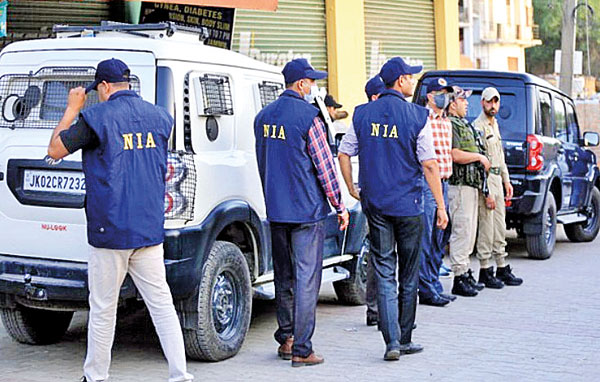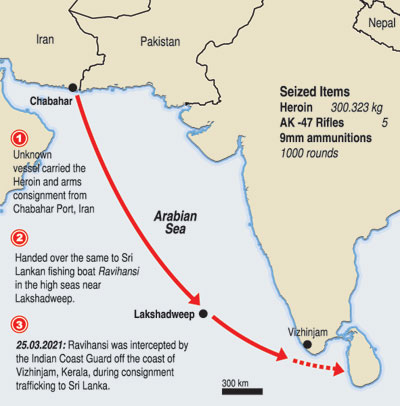News
Narcotics and arms: Deadly combination to revive LTTE
View(s):- Indian detectives expose fresh attempts to resuscitate the terror group Lanka defeated 14 years ago
- 13 suspects, including ten Sri Lankans, arrested by India’s National Investigation Agency; Pakistan-based Haji Salim identified as key source of drugs
By S. Rubathesen and Sandun Jayawardana
Last week, India’s National Investigation Agency (NIA) filed a charge sheet against 13 suspects–10 Sri Lankans and three Indians–for their involvement in the drug and arms trade as well as attempts to revive the LTTE in the two countries. The Sri Lankan suspects include those alleged to be leading the drug traffickers. Among them are the notorious “Kimbula Ele Guna” and his son.
Sri Lankan law enforcement authorities are keeping a close watch on the Indian investigation. The Criminal Investigation Department (CID) and the Police Narcotics Bureau (PNB) say that although the case is being probed by the Indian authorities, there exists strong inter-agency cooperation between the two countries in cases involving narcotics and terrorism. The Terrorism Investigation Department (TID) did not respond to a request for comment.
After almost two years of investigation, detectives of India’s National Investigation Agency, a premier agency probing narcotics and terrorism cases, uncovered an alleged plot to use the proceeds of the illegal drug trade in an unsuccessful attempt to revive the LTTE both in India and Sri Lanka, fourteen years after its military defeat.
The charge-sheeted Indians are Selvakumar M, Vigneshwara Perumal alias Vicky and Iyyapan Nandhu alias Ayyappan Nandhu.
The Sri Lankan suspects are C. Gunasekaran alias Guna, Pushparajah alias Pookutti Kanna, Mohammad Asmin, Alahapperumaga Sunil Ghamini Fonseka, Stanly Kennady Fernando, Dhanukka Roshan, Nalin Chathuranga alias Ladiya, Gamage Suranga Pradeep alias Welle Suranga, C. Thilipan alias Dileepan and Danarathnam Nilukshan.
“The charge-sheeted men had conspired with the accused in the Vizhinjam Arms case (RC- 01/2021/NIA/KOC) to exploit the illegal drugs trade in India and Sri Lanka for funding, amassing and stashing weapons for the revival of the LTTE in India and Sri Lanka. The drugs were being sourced from one Haji Salim, who is suspected to be residing in Pakistan. The accused persons had been using various foreign WhatsApp numbers to carry out the clandestine trade,” an official statement from NIA said.
The Vizhinjam Arms case relates to the seizure by Indian authorities of a Sri Lankan multi-day fishing trawler named “Ravihansi” on March 25, 2021 (See box for a related story). Following a tip-off made to the NIA office in Kochi, Kerala, the vessel was intercepted in India’s territorial waters near Thiruvananthapuram. The authorities seized 301 kilograms of heroin, five AK-47 assault rifles, and about 1000 rounds of 9mm ammunition from the vessel, according to a First Information Report (FIR) filed in the Special Court for NIA cases in Ernakulam. The six-member Sri Lankan crew was also taken into custody.

India's NIA sleuths say the 13 suspects were part of a network to revive the LTTE
The charge sheet seen by the Sunday Times noted that India’s Central government directed the NIA to take over the investigation after “having regard to the gravity of the offence and its ramifications on national and international security, it is required to be investigated by the NIA in accordance with National Investigation Act- 2008.”
Seven months later, the NIA arrested a former LTTE intelligence wing member Satkunam alias Sabesan (47) — at his residence in Chennai. “He had played a crucial role in routing the proceeds of drug trafficking to former LTTE cadres in Sri Lanka for the revival of the LTTE,” the agency said in a statement following the arrest.
Further investigations by NIA revealed a major conspiracy to fund the revival of LTTE through drug trade with the arrest of four individuals at the Trichy Special Camp for Sri Lankan refugees. This is the case in which 13 Sri Lankans and three Indians have been arrested. One Sri Lankan is absconding. Last week’s charge sheet filed by the NIA in the Poonamallee special court in Tamil Nadu links the accused in this case to the Vizhinjam drugs and arms seizure case. It alleges that some of the accused in the two cases met in August 2020 ina Chennai, and conspired to revive the LTTE. Drug trafficking was their preferred route to raise money to buy arms and accumulate finances for their plan, the charge sheet alleges.
“The NIA also seized various digital devices, documents relating to drug transactions, cash to the tune of Rs 80 lakh, and nine gold bars during the course of the investigations. This cash and gold were proceeds from the sale of narcotics and were being channeled through hawala networks between Chennai and Sri Lanka. Several transactions using Crypto platforms were also unearthed between the accused,” said the NIA statement announcing charges against the 13 suspects.
The charge sheet also says Gunasekeran even signed up as a member of an Indian political party — the Democratic Party of India — and became vice-president of its Tamil Nadu unit with the “dubious” intent of rallying political support in the southern state, which has a history of supporting the LTTE. The Sunday Times is checking on Gunasekaran’s involvement with such a party as well as the party’s antecedents.
The shadowy Haji Salim, who Indian authorities link to the drug and arms trade between India and Sri Lanka, is thought to have connections with several leading Sri Lankan drug traffickers including Mohamed Najim Mohamed Imran alias “Kanjipani Imran.” Imran was arrested in Dubai in 2019 and deported to Sri Lanka. He was in remand custody till being granted bail by court on December 20, last year. He was released on a personal bail of Rs. 5 million and was also barred from travelling overseas. Indian media, however, reported earlier this year that he had sneaked into Tamil Nadu from Sri Lanka and that Indian Police were on the lookout for him.
The special edition annual report 2022 released by India’s Narcotics Control Bureau (NCB) noted that maritime drug trafficking in the Arabian Sea and the Bay of Bengal poses new challenges to drug law enforcement agencies and they anticipate increase use of this route by international drug trafficking syndicates operating from Pakistan and Afghanistan.

Interception of maritime drug trafficking, especially in the western region of India, has seen an increase. Most of such seizures were sourced from the ports in Afghanistan or Iran, and destined to coastal states of India or were in further transit to countries like Sri Lanka and the Maldives. White heroin is the most trafficked drug through the maritime route, while other drugs like ATS, charas and cocaine are also seized, according to a Hindustan Times report.
As Sri Lanka is fast becoming the “transit hub” of narcotics smuggling in the Indian Ocean in recent years, the government stepped up intelligence sharing and coordination on defence matters with regional countries, particularly with India, to curb such activities.
“We have a regional network in place to prevent narcotics being smuggled through the country’s waters or into the country. As of now, we mainly depend on physical sources for our operations,” Defence Ministry Spokesperson Lt. Col. Nalin Herath told the Sunday Times.
With smugglers adopting new tactics, the Defence Ministry is also updating its technological capabilities to face emerging challenges. “For this, assistance from both the United States and India is important,” he noted.
For the first six months of this year, Sri Lanka’s security forces have seized 507 kilograms of heroin, 6,013 kilograms of Kerala ganja (cannabis) and 3,876 kilograms of local cannabis, according to Defence Ministry statistics.
| Customs detect 16kg of heroin in potato-carrying container Sri Lanka Customs officials on Wednesday uncovered 12 parcels containing more than 16 kilograms of heroin concealed inside the ventilator cover of a refrigerated container that had arrived from Pakistan. The container was aboard the vessel ‘Wide Juliet’ which had arrived from Karachi. Following a tip-off, Customs officers from the Port Control Unit seized the container when the vessel docked at the Colombo Port on June 15. When the container, which contained fresh potatoes, was examined on Wednesday, the Customs officers discovered the 12 parcels of heroin, weighing 16.193 kilograms, the street value of which is estimated to be Rs. 650 million, according to Customs officials.
| |
| Ravihansi suspects’ wives say their husbands are innocent, point finger at vessel ownerBy Gamini Mahadura The Sunday Times spoke to the wives of three of the six suspects arrested when the narcotics-smuggling vessel Ravihansi was intercepted by the Indian authorities in March 2021. They insist their husbands are innocent and blame the owner of the multi-day fishing trawler for the smuggling racket. They say the vessel owner from Kudawella in Matara has been missing since the day the news of the vessel’s capture reached Sri Lanka. The women say they were struggling to make ends meet and look after their young children without the support of their husbands. They urge the government to intervene and secure the release of their husbands.
One of those arrested from the vessel was Ranasingha Nilanga Madushan (31), of Imbulagoda, Rathgama. Nilanga was a member of the multi-day fishing trawler Ravihansi which the Indian Coast Guard intercepted in India’s waters and recovered 300 kilograms of heroin, five AK-47 assault rifles and about 1000 rounds of 9mm ammunition. Nilanga joined the Sri Lanka Army in 2009 and served for six years. He thereafter worked at a restaurant in Matara, and was subsequently recruited by a friend to work on fishing boats, said his wife S.M. Sashikala Virajini (29). The couple has an eight-year-old daughter who saw her father last when he set out to sea aboard Ravihansi from the Kudawella Fishery Harbour in Matara on March 7, 2021. Shashikala says that after the arrest of the crew they were separated and have been detained in two prisons. “My husband phones me from the Indian prison about once a month. He is innocent. The real culprit is the vessel owner who is in hiding,” Sashikala said, pleading for the government’s intervention for his release. A.P. Hemal Sathyajith Mendis Gunasekara (33) is a father of three young girls. He had been working as a labourer when a friend encouraged him to join a fishing boat. Ravihansi was his first experience on a fishing vessel and it was on the very first trip that he was arrested, his wife Sashika Dilrukshi (28) said. Since her husband’s arrest, Sashika has been working in a garment factory to provide for her three children, aged 8, 6 and 3. She said her husband called her from prison and informed her recently that their case is now being heard in an Indian court. S.A. Thamesh Chullaka (36) from Wellathotawatta, Rathgama, served in the army for 13 years before he was discharged after his involvement in a quarrel with some villagers. He then worked as a welder before going out to work on fishing boats. His wife Gayani Nisansala (35) said she had to give up her job at the garment factory as the salary was no enough to care for her two boys aged 10 and 4. She now earns a living from grinding salt. |
The best way to say that you found the home of your dreams is by finding it on Hitad.lk. We have listings for apartments for sale or rent in Sri Lanka, no matter what locale you're looking for! Whether you live in Colombo, Galle, Kandy, Matara, Jaffna and more - we've got them all!


